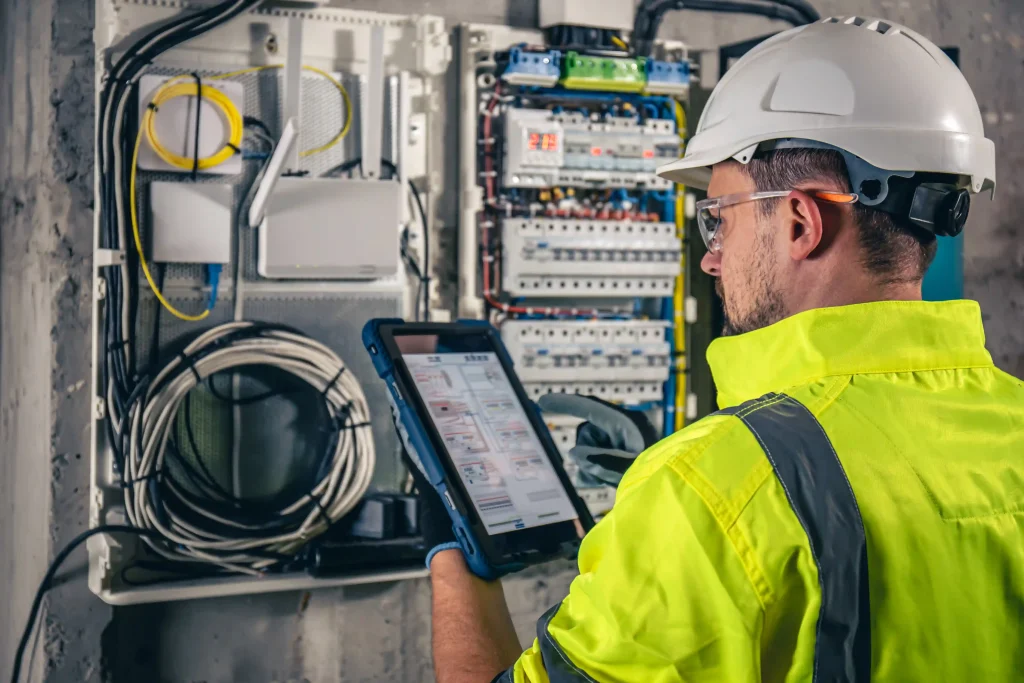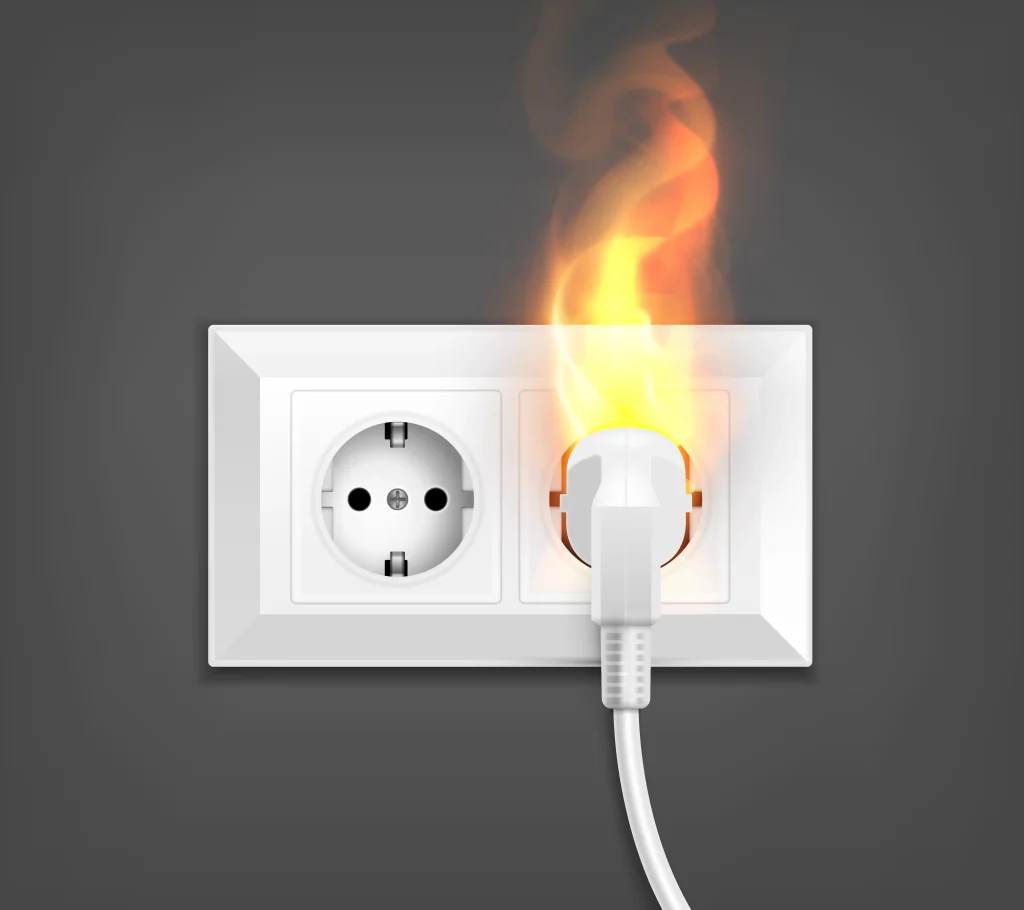Electrical compliance testing is a bit like a health check-up for your home’s wiring – tedious perhaps, but definitely worth it. Imagine you just bought a charming old house in Albany, only to discover that behind its quaint façade hides some dodgy wiring. Cue the flat white on the table. A quick reminder from your electrician: you’ll need a compliance certificate or risk a hefty fine. Ignoring it is like skipping a vaccination: it might seem fine now, but you could pay dearly later. In fact, electrical faults cause nearly 40% of house fires in Australia. Think of electrical compliance testing as a flu shot for your house – small pinch now, big headache (or worse) avoided later.
Electrical compliance testing covers everything from safety switches (RCDs) to powerpoints and appliances. In simple terms, it means having a licensed electrician check that all your circuits and devices meet Australian safety standards. They’ll test safety switches, test & tag your appliances, and inspect the switchboard – sort of like a mechanic giving your car a full service. Why care? Because without it, faulty wiring can lurk unnoticed. And remember: if you ever do sell or lease your property, regulators expect an up-to-date compliance report, especially in WA where “at least two RCDs must be fitted to protect all power and lighting circuits” in older homes. So yes – electrical compliance testing matters for your wallet, your tenants’ safety, and for dodging unwelcome council fines.

What is Electrical Compliance Testing and Why Should You Care?
Think of electrical compliance testing as a safety MOT for your building. It involves a qualified electrician inspecting and testing key parts of your electrical system to ensure everything is up to scratch. This can include: RCD (safety switch) checks, test-and-tag of portable appliances, and switchboard inspections. In everyday terms, it’s making sure the power won’t suddenly go rogue – no shocking surprises.
- RCD Testing (Safety Switches): These are the lifesavers that cut power if a fault occurs. You can’t easily see them failing, so the electrician will “push the test button” and measure how long it takes to trip. WA’s guidelines even recommend you do a quick push-test yourself every 3 months, and get a pro to do a proper timing test about once a year.
- Test & Tag (Portable Appliances): This is where each plug-in device (like kettles, power tools, heaters) gets visually inspected and given an electrical test. If it passes, it gets a tag with a future retest date. AS/NZS 3760:2022 (the safety standard) says the interval for this varies – a home workshop drill might be checked yearly, while a hotel’s kettles need it every 12 months.
- Switchboard/Fixed Wiring Inspection: The electrician will peer into your switchboard, check for wear, corrosion or dangerous modifications. Old fuse boxes or DIY wiring can fail invisible checks, so they’ll ensure everything’s earthed correctly and up to today’s codes.
Why go to all this trouble? Because it’s your best defense against hazards and fines. A compliance check finds sneaky problems: a frayed wire that could spark a fire, or a missing earth that could electrify a tap. NSW government data warns that thousands of house fires each year are due to electrical faults – many of which routine testing would catch. Plus, compliance ties directly into WA regulations: a license-holder must do testing properly, or you (or they) could face penalties. In short, caring about compliance testing is caring about safety – and about not getting hit with expensive fines or insurance headaches down the line.
Albany’s Rules and Who Must Comply
In Western Australia (and Albany is no exception), the laws are clear: any electrical work has to be done safely and by the book. That means only licensed electricians can touch your wiring, and certain safety measures (like RCDs) are mandatory. Here’s what you need to know:
- Property Owners (Home & Landlords): If you own the property, it’s on you to keep the electrics safe. For rental homes, WA rules now say older houses must have at least two safety switches protecting all circuits. Landlords and property managers should ensure these RCDs are installed and functioning. Even the WA Building & Energy department recommends testing them at least quarterly. New buyers? The settlement process usually won’t let you off the hook either – you’ll need proof (often an electrician’s certificate) that all is good before handing over the keys.
- Businesses & Commercial Owners: If you run a store, office, or workshop, compliance is even bigger. Workplaces in WA are bound by OSH regulations: regularly testing and tagging equipment is mandatory (especially on construction sites). A safety inspector could show up expecting a full compliance check; if your place has never been tested, you’ll be playing catch-up under scrutiny.
- Electricians/Contractors: The flip side is on the tradespeople. The law requires your electrician to hold a valid WA electrical licence (checkable on the WA Gov site) and to issue a Certificate of Compliance after doing the work. If your sparky skips that or isn’t licensed, you – the homeowner – can also end up in hot water. For example, failing to issue a compliance certificate can attract fines up to roughly half a million dollars (and that’s per violation!).
Quick Tip: If your Albany home is as old as a vinyl record, treat it like one. Older properties often need more checks – think of compliance testing as giving a vintage car a full service before hitting the road.
Avoiding Fines: What Can Go Wrong Without Testing
Think skipping an electrical check is a shortcut? It can backfire in a big way. Real talk: I once heard about a local landlord who ignored a worn-out power point. During an inspection, that dodgy outlet shorted and sparked a small fire, and boom – a hefty fine from the city council for non-compliance. In WA’s own words, “the issue would have easily been detected if the electrical worker had carried out mandatory checks and tests”. In that case, the contractor and electrician ended up paying a combined $18,500 penalty. That’s the kind of story you really don’t want to be your own.
The worst part is, the fallout isn’t just one-off. Here’s what skipping compliance can lead to:
- Voided Insurance: Many insurers now scrutinize electrical safety. If a fire breaks out from a fault that should have been caught in a test, your claim might be rejected. In fact, one electrician warns that insurers may refuse fire claims if the property lacks a recent electrical compliance check.
- Council Penalties: Councils and regulators take a dim view of uncertified properties. You could get pulled up for unsafe wiring or missing safety switches, leading to fines or orders to fix up immediately. As one commercial safety guide bluntly puts it, electrical faults can “cause serious injuries, shut down your operations, or leave you facing huge fines under Australian safety laws”.
- Safety Risks: The worst cost is to life and property. A hidden fault can trigger shocks or fires (remember the 40% fire stat). Tenants could get hurt, property could burn – and then you’re dealing with lawsuits on top of everything.
- Business Disruption: For a business owner, it can mean days of downtime. Imagine a local café in Spencer Park forced to close for 10 days after its outdated wiring failed inspection. The lost revenue (and fixed fines) would dwarf the cost of the compliance test in the first place.
Bottom line: skipping compliance is a gamble where you lose. Don’t roll the dice when a quick test and tag could save you thousands, or worse.
Signs You Might Be Non-Compliant (and Not Know It)
Many people assume “if the lights come on, it’s fine.” But there are giveaways that your setup needs checking. Here’s a home checklist you can run through right now:
- Flickering or Buzzing Lights: Intermittent lights or appliances that hum like bees? Loose wiring or overloaded circuits could be the culprit. It’s often a sign your system is struggling.
- Frequent RCD Trips or Tripping Breakers: If your safety switch keeps tripping on its own, it might actually be doing its job – meaning something’s wrong. Don’t just reset it repeatedly and ignore.
- Warm, Discolored or Scorched Outlets: Gently touch outlets and faceplates. Any heat, burn marks or plastic warping is a red flag. It means excessive current or poor connection – time to get them tested.
- Old or Ungrounded Plug-Ins: Check if your home has any 2-prong (ungrounded) outlets in living areas – Australia phased those out long ago. Also look at cable insulation: cracked or brittle cords on appliances mean danger.
- No RCDs (Safety Switches) Installed: Any home built before the mid-90s should have been retrofitted with RCDs. If your switchboard has no obvious “Test” button (or it’s an ancient fuse box), it’s non-compliant by modern standards.
- DIY or Messy Wiring: Homemade extensions, randomly tucked wires behind the fridge, or suspicious “tape fixes” – these are clues that the system might not meet legal safety criteria.

DIY Audit: Walk through your place with a flashlight. If anything looks not professionally done (like a hastily spliced cable or jury-rigged extension), note it down. Even minor issues compound: more outlets on an overloaded powerboard can cause fires later. Remember, just turning the key at night doesn’t prove compliance – only a proper test will.
How to Book and Prepare for Electrical Compliance Testing in Albany
Ready to get on top of it? Here’s your step-by-step game plan:
- Find a Licensed Electrician: Only hire licensed trades (WA law says it’s illegal otherwise). Use the WA Government’s Online Licence Search to verify any sparkie’s credentials. Ask friends for local tradie recommendations too.
- Ask About the Certificate: When you book, clarify you need a Certificate of Electrical Compliance (CEC) at the end. By law, your electrician will issue this to prove everything’s up to code. (Skipping this is risky – fines can reach around $550,000 for non-issuance.)
- Schedule the Check: Pick a date when the electrician can have full access. They’ll likely want to switch off power to inspect circuits, so plan for any downtime.
- Prepare Your Home: To speed things up (and maybe save a few bucks), do a quick prep: unplug extension leads and devices from powerboards, label any hard-to-reach outlets, and make sure the meter/switchboard area is accessible (clear away boxes or furniture). The electrician will appreciate clear access and fewer obstructions.
- Expect the Duration: A full residential compliance check typically takes 1–3 hours, depending on house size and wiring complexity. Costs vary, but most Perth and regional WA sources cite $100–$250 for a basic home inspection. Larger properties or industrial sites can run more. Think of it as a small insurance policy – a few hundred now beats thousands later.
By being proactive (and helpful on-site), you might get a smoother process and even a better rate. Remember, this isn’t a surprise raid – licensed electricians want your property safe too.
Electrical Compliance Testing Isn’t a One-Off (Schedule It Right)
OK, so you got everything checked today. Does that mean never worry again? Nope – electrical compliance is like regular health screening: it needs repeating. Different places have different rhythms:
| Property Type | RCD Testing (Safety Switches) | Test & Tag (Portable Appliances) | Switchboard Inspections |
|---|---|---|---|
| Homes/Residential | Every 1–2 years (push-test DIY quarterly) | Varies: 1–5 years (rarely needed for strictly domestic settings) | Every ~5 years (or if there are changes like renovations) |
| Commercial/Workplaces | Every 6 months (often mandated by WHS/OHS regs) | Every 3–12 months depending on use (e.g. heavy-duty power tools or rented equipment may need 3–6 monthly) | Every 2 years (or more often if equipment is heavily used) |
| Rental Properties | With each new lease or at least every 2–5 years | As needed (best practice: align with routine inspection schedules) | Every 2–3 years (especially if tenants change) |
Table: Typical safety check intervals – adapt to your use and professional advice. These aren’t laws written in stone, but they reflect industry best-practice (per AS/NZS 3760 guidelines and local advice). In short, businesses and rentals should check more often than a single homeowner. Set a reminder: for example, mark your calendar or phone 12 months out.
Pro Tip: Add your next test-date to the homeowner’s diary (or ask your property manager to do it). After all, it’s easier to stay safe on schedule than to scramble after a notice of breach.
The Cost of Non-Compliance: More Than Just a Fine
By now you get it – ignoring compliance sucks. But let’s dig a bit deeper: the full cost of skipping tests can be much higher than the bill for an inspection. Here’s what else you risk:
- Insurance Headaches: As mentioned, voided claims can bleed you dry. Dealing with a destroyed property plus an insurer decline? That could wipe out your savings faster than a fuse blows.
- Loss of Income: For landlords, a safety recall might force you to find emergency accommodation for tenants (because an inspector could red-tag the home). Expect lost rent until repairs/certification is done. For businesses, an unexpected shutdown means payroll and bills still come, but no sales.
- Council Shutdown Orders: In WA, the local building official or fire authority can order unsafe premises to be vacated immediately. You’d have to fix everything at once (often on short notice) – think contractors charging rush rates or emergency switchboard replacements. Not fun.
- Reputational Damage: If word gets out a rental or office had fire hazards, tenants or customers will lose trust. A quick compliance test is cheap insurance against scandal.
Case in point: A cosy Albany café skipped its compliance review and later discovered outdated wiring near the espresso machine. The cafe had to close for ten days during repairs, costing them over $8,000 in lost revenue (not counting the repair bills) – that’s real money for a small biz.
In reality, the small yearly fee for electrical compliance testing is tiny compared to these potential losses. Treat it as preventive maintenance. It’s like changing the oil in your car; ignore it and you’ll eventually replace the engine.
How to Choose the Right Electrician in Albany
Finding a good sparkie is key. Here’s how to make sure you pick a real pro, not a cowboy:
- Verify the Licence: Always use the WA Building and Energy register or the Online Licence Search to confirm their licence number. If they dodge the question or don’t have a licence, run the other way.
- Check Reviews/References: Look up local electricians on Google or ask neighbours and friends in Albany or Mt Barker who they trust. Good electricians often work in the same area and have a reputation among local property managers.
- Ask About Compliance Experience: A seasoned electrician should know Albany’s (and WA’s) rules – ask if they regularly do compliance checks and issue certificates. They should have no trouble explaining your obligations.
- Watch for Warning Signs: Lowball quotes or refusals to provide a written estimate/certificate are red flags. Licensed tradies should have no issue documenting their work. Also, if a salesperson tries to scare you into unnecessary upgrades or refuses to answer questions – that’s a problem.
Deal-makers: Choose someone who’s friendly, responsive, and makes you comfortable – electrical work can be complicated, and you want to trust the person poking around your fusebox. Remember, “licensed electrician” isn’t just a title; as WA’s safety body notes, only licensed electricians meet the required competency standards. Don’t risk an uncertified job – it could come back to bite you harder than any circuit.
Final Checklist: Stay Safe and Fine-Free
Ready to be a compliance champion? Here’s a simple takeaway list to keep handy:
- Schedule Regular Inspections: Put your next test date on the calendar (seasonal reminders help!).
- Keep Certificates in a Safe Place: After each inspection, file the compliance certificate with your home documents or with your property manager.
- Trustworthy Electrician on Speed Dial: Have contact info for a local licensed Albany electrician – so you can act fast on any advice or fixes.
- Monitor House Age & Changes: Older homes and renovations = set off your reminder to test.
- DIY Checks: Do a quick RCD test (press the button on your switchboard) every 3 months, and call the electrician if anything trips when it shouldn’t.
Remember: Electrical compliance testing is like a flu shot for your house – it’s a small effort now that prevents big headaches later. Don’t leave it to chance (or to the fire brigade)!
Act Now: Give a licensed Albany electrician a ring and book your next electrical compliance test. Your wallet (and walls) will thank you – and you’ll sleep better knowing your home is truly safe.
FAQs
How often should electrical compliance testing be done in Albany?
For homes, a full compliance check is often recommended every 2–5 years (longer if nothing changes). For businesses or rental properties, testing is usually needed more frequently – often every 6–12 months depending on usage and equipment. If in doubt, ask a licensed electrician.
What happens if I fail an electrical compliance test?
Failing means any hazards must be fixed before re-testing. You’ll likely face orders to repair faults (which can be costly), your insurer might refuse claims for related incidents, and you could be fined under Australian safety laws.
Do I need a certificate after compliance testing?
Yes. In WA, the electrician is legally required to issue a Certificate of Electrical Compliance once the work/test is done. This certificate proves the job met all safety rules. Without it, you’re not officially compliant.

